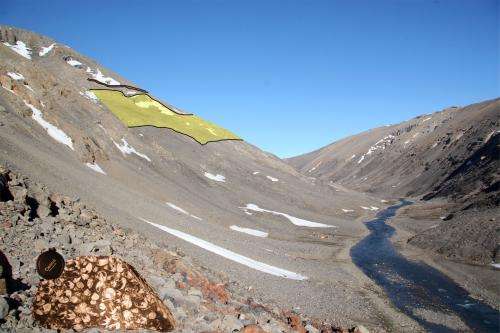USA's ancient hurricane belt and the US-Canada equator

The recent storms that have battered settlements on the east coast of America may have been much more frequent in the region 450 million years ago, according to scientists.
New research pinpointing the positions of the Equator and the landmasses of the USA, Canada and Greenland, during the Ordovician Period 450 million years ago, indicates that the equator ran down the western side of North America with a hurricane belt to the east.
The hurricane belt would have affected an area covering modern day New York State, New Jersey and most of the eastern seaboard of the USA.
An international research team led by Durham University, UK, used the distribution of fossils and sediments to map the line of the Ordovician Equator down to southern California.
The study, published in the journal Geology, is the first to accurately locate and map the ancient Equator and adjacent tropical zones. Previous studies had fuelled controversy about the precise location of the ancient equator. The researchers say the new results show how fossils and sediments can accurately track equatorial change and continental shifts over time.

Co-lead author Professor David Harper, Department of Earth Sciences, Durham University, UK, said: "The equator, equatorial zones and hurricane belts were in quite different places in the Ordovician. It is likely that the weather forecast would have featured frequent hurricane-force storms in New York and other eastern states, and warmer, more tropical weather from Seattle to California."
Since Polar Regions existed 450 million years ago, the scientists believe that there would have been similar climate belts to those of today.
The research team from Durham University, UK, and universities in Canada, Denmark and the USA, discovered a belt of undisturbed fossils and sediments -deposits of shellfish- more than 6000 km long stretching from the south-western United States to North Greenland. The belt also lacks typical storm-related sedimentary features where the deposits are disturbed by bad weather. The researchers say that this shows that the Late Ordovician equatorial zone, like the equatorial zone today, had few hurricane-grade storms.
In contrast, sedimentary deposits recorded on either side of the belt provide evidence of disturbance by severe storms. Hurricanes tend to form in the areas immediately outside of equatorial zones where temperatures of at least 260C combine with the Earth's rotation to create storms. The researchers believe that hurricane belts would probably have existed on either side of the ancient equator, within the tropics.
The position of the equatorial belt, defined by undisturbed fossil accumulations and sediments, is coincident with the Late Ordovician equator interpreted from magnetic records (taken from rocks of a similar age from the region). This provides both a precise equatorial location and confirms that the Earth's magnetic field operated much in the same way as it does today.

The scientists pieced together the giant jigsaw map using the evidence of the disturbed and undisturbed sedimentary belts together with burrows and shells. Using the findings from these multiple sites, they were able to see that North America sat on either side of the Equator.
Co-author Christian Rasmussen, University of Copenhagen, said: "The layers of the earth build up over time and are commonly exposed by plate tectonics. We are able to use these ancient rocks and their fossils as evidence of the past to create an accurate map of the Ordovician globe."
Professor Harper added: "The findings show that we had the same climate belts of today and we can see where North America was located 450 million years ago, essentially on the Equator."
"While the Equator has remained in approximately the same place over time, the landmasses have shifted dramatically over time through tectonic movements. The undisturbed fossil belt helps to locate the exact position of the ancient Laurentian landmass, now known as North America."
More information: Precisely locating the Ordovician equator in Laurentia, J. Jin et al., Geology, doi: 10.1130/G33688.1
Journal information: Geology
Provided by Durham University




















